
![]()
Search the Journey to Forever website – click HERE
|
Journey to Forever: Make a donation |
En español
Biocombustibles, biodiesel
Navigation
Contact usTo Keith Addison Handmade Projects |
Wood gas as motor fuel
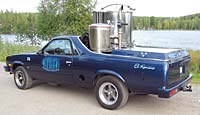 Vesa Mikkonen is chairman of the Association of Ecological Motorists in Finland. He has driven more than 110,000 km on wood gas over the past 15 years, and has encouraged many drivers in Finland to build their own wood gas fuel systems.
Vesa Mikkonen is chairman of the Association of Ecological Motorists in Finland. He has driven more than 110,000 km on wood gas over the past 15 years, and has encouraged many drivers in Finland to build their own wood gas fuel systems.
Vesa's book Wood Gas for Mobile Applications is a detailed and thorough manual on building a wood gas fuel system for your car. 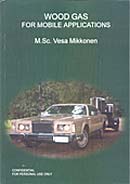 First published in Finnish in 1999, the book is now in its 3rd English edition, with 307 pages, lavishly illustrated with hundreds of photographs, diagrams, construction blueprints and parts lists.
First published in Finnish in 1999, the book is now in its 3rd English edition, with 307 pages, lavishly illustrated with hundreds of photographs, diagrams, construction blueprints and parts lists.
The first part of the book is a detailed overview of the wood gas concept, how it works, and building and using a gasifier; the second part covers the construction of several complete wood gas systems, all tried and tested and proven in practice on the road. These systems can be built by any experienced home mechanic. If you're interested in wood gas for fuel independence, this is the best resource.
Wood Gas for Mobile Applications -- brochure and Table of Contents:
http://www.ekomobiili.fi/Tekstit/Bookbrochure.pdf
Renewable Energy for Housing and Transportation -- Vesa Mikkonen's website (in English):
http://www.ekomobiili.fi/Tekstit/english_etusivu.htm
Email: Vesa Mikkonen <vesa.mikkonen@ekomobiili.fi>
Finnish Eco-car Association (wood fueled car association) (in Finnish)
http://www.ekoautoilijat.fi/
Wood gas cars in Finland (many), with photographs
http://www.ekoautoilijat.fi/tekstit/kalustoesittely.htm
 Jonathan Spreadborough's American Woodgas Site features current woodgas trucks and cars in the US:
Jonathan Spreadborough's American Woodgas Site features current woodgas trucks and cars in the US:
http://www.woodgas.net/
Including Jonathan's own 1990 Ford F-250 fuel injected 5.0L truck, featured in a May 2008 article in the Lincoln Journal Star, "Martell man's Ford burns wood, not gas":
http://www.journalstar.com/articles/2008/05/29/news/
local/doc483de2c0af079325623826.txt
 The Gengas Page -- Fuel gas, produced by the reduction of coal and peat, was used for heating as early as 1840 in Europe, and by 1884 it had been adapted to fuel engines in England. Petroleum shortages during World War II led to widespread gas generator applications in the transportation industries of Western Europe. (Charcoal-burning taxis, a related application, were still common in Korea as late as 1970.) This report attempts to preserve the knowledge about wood gasification as put into practical use during World War II. Detailed, step-by-step procedures are presented in this report for constructing a simplified version of the World War II, Imbert wood gas generator. Full text online.
The Gengas Page -- Fuel gas, produced by the reduction of coal and peat, was used for heating as early as 1840 in Europe, and by 1884 it had been adapted to fuel engines in England. Petroleum shortages during World War II led to widespread gas generator applications in the transportation industries of Western Europe. (Charcoal-burning taxis, a related application, were still common in Korea as late as 1970.) This report attempts to preserve the knowledge about wood gasification as put into practical use during World War II. Detailed, step-by-step procedures are presented in this report for constructing a simplified version of the World War II, Imbert wood gas generator. Full text online.
http://www.gengas.nu/byggbes/index.shtml
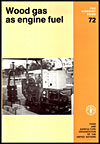 Wood gas as engine fuel, Mechanical Wood Products Branch, Forest Industries Division, FAO Forestry Department, 1986, ISBN 92-5-102436-7
Wood gas as engine fuel, Mechanical Wood Products Branch, Forest Industries Division, FAO Forestry Department, 1986, ISBN 92-5-102436-7
The harmful effect of high and rising oil prices on the economies and development efforts of oil-importing developing countries have become apparent. There has, as a result been increased interest in indigenous, renewable energy sources, of which biomass in the form of wood or agricultural residues is the most readily available in many developing countries. In many developing countries -- in particular in rural areas -- internal combustion engines are widely used in stationary applications such as electric power generation and operation of water pumps and mills. Technologies such as gasification, which allow utilization of biomass fuel in such engines after minimum preparation, are therefore of particular importance. A summary of modern wood gasification technology and the economics of its application to internal combustion engines. Full; text online.
http://www.fao.org/DOCREP/T0512E/T0512e00.htm
 The making of the Källe-gasifier by Torsten Källe, Royal Swedish Academy of Engineering, 1942 (Translation to English 2000, Joacim Persson -- Torsten Källe's charcoal gasifier was somewhat ahead of its time. It was very popular due to its easy maintenance and fuel economy. Some features of this gasifier are perhaps recognised in modern gasification technology; among many things it was a sort of predecessor to what today is called 'circulating fluidised bed.' Charcoal gasifiers were generally more popular than wood gasifiers during the producer gas era in Sweden in the days of WW2, even as the wood gasifiers improved in design. Wood gas was cheaper, but charcoal gasifiers were so much easier to handle.
The making of the Källe-gasifier by Torsten Källe, Royal Swedish Academy of Engineering, 1942 (Translation to English 2000, Joacim Persson -- Torsten Källe's charcoal gasifier was somewhat ahead of its time. It was very popular due to its easy maintenance and fuel economy. Some features of this gasifier are perhaps recognised in modern gasification technology; among many things it was a sort of predecessor to what today is called 'circulating fluidised bed.' Charcoal gasifiers were generally more popular than wood gasifiers during the producer gas era in Sweden in the days of WW2, even as the wood gasifiers improved in design. Wood gas was cheaper, but charcoal gasifiers were so much easier to handle.
http://www.hotel.ymex.net/~s-20222/gengas/kg_eng.html
Homemade Motor Fuel... From Firewood -- Mother Earth News March/April 1981
http://www.motherearthnews.com/library/1981_March_April/
Homemade_Motor_Fuel___From_Firewood
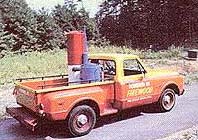 MOTHER's Woodburning Truck -- After 1,500 miles of free-fuel driving, we found that you can run a truck using firewood for fuel. This article includes detailed diagrams, photographs and how the wood/gas generator was constructed. -- Mother Earth News May/June 1981
MOTHER's Woodburning Truck -- After 1,500 miles of free-fuel driving, we found that you can run a truck using firewood for fuel. This article includes detailed diagrams, photographs and how the wood/gas generator was constructed. -- Mother Earth News May/June 1981
http://www.motherearthnews.com/Alternative_Energy/1981_May_June/
Mother_s_Woodburning_Truck
Wood-Gas Update -- More about MOTHER's woodburning truck and homestead electricity-generating plant; including cutaway detailed diagrams of the conversion process. -- Mother Earth News September/October 1981
http://www.motherearthnews.com/Alternative_Energy/
1981_September_October/Wood_Gas_Update
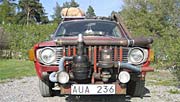 Around Sweden with wood in the tank -- "We started to build the car on New Year’s eve and many days, evenings and nights were sacrificed during the spring, to make the wood gas system and car working. We got a mishmash of Swedish cultural heritage that witnesses of traditional Swedish car industry, a tough war and 'farmers resourcefulness'. The car took us 5,420 km in 20 days, using 7 square metres of wood." How it works, the car, the roadtrip, travel blog, construction blog and more.
Around Sweden with wood in the tank -- "We started to build the car on New Year’s eve and many days, evenings and nights were sacrificed during the spring, to make the wood gas system and car working. We got a mishmash of Swedish cultural heritage that witnesses of traditional Swedish car industry, a tough war and 'farmers resourcefulness'. The car took us 5,420 km in 20 days, using 7 square metres of wood." How it works, the car, the roadtrip, travel blog, construction blog and more.
http://www.vedbil.se/indexe.shtml
The Woodfired Gas Producer -- the Australian woodgas odyssey: "We reckoned on about 2,000 km per tonne of wood (2km/kg). This should be improved by the addition of steam to an expected 2,500-3,000 km per tonne. The amount of water used is about the same as the gallonage of petrol that would be consumed." Detailed description, with drawings. http://members.tripod.com/~highforest/woodgas/woodfired.html
"Small-Scale Biomass Gasifiers for Heat and Power -- A Global Review", by Hubert E. Stassen, World Bank Technical Paper Number 296, 1995, 88 pages -- A lot of information on woodgas. 3.5 Mb pdf:
http://www.woodgas.net/files/
World%20bank%20tech%20paper%20296.pdf
Alternatives to Fossil Fueled Engine/Generators, by Clifford W. Mossberg -- Woodgas for engines and for power -- From Homepower Magazine. Acrobat file, 176kb
History of Woodgas, by Tom Reed of the Biomass Energy Foundation
http://www.woodgas.com/History.htm
 Woodgas Powered VW's and Other Vehicles
Woodgas Powered VW's and Other Vehicles
http://www2.whidbey.net/
lighthook/woodgas.htm
Biofuels
En español -- Biocombustibles, biodiesel
Biofuels Library
Biofuels supplies and suppliers
Biodiesel
Make your own biodiesel
Mike Pelly's recipe
Two-stage biodiesel process
FOOLPROOF biodiesel process
Biodiesel processors
Biodiesel in Hong Kong
Nitrogen Oxide emissions
Glycerine
Biodiesel resources on the Web
Do diesels have a future?
Vegetable oil yields and characteristics
Washing
Biodiesel and your vehicle
Food or fuel?
Straight vegetable oil as diesel fuel
Ethanol
Ethanol resources on the Web
Is ethanol energy-efficient?